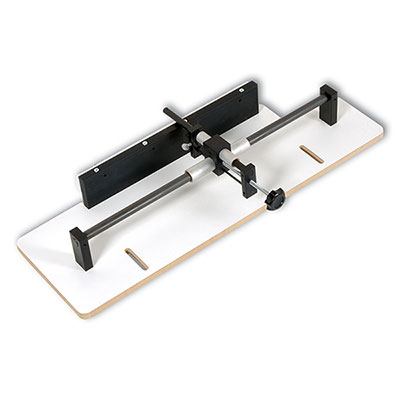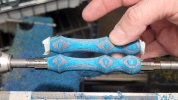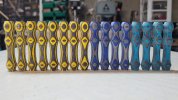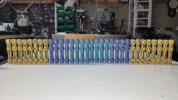You are using an out of date browser. It may not display this or other websites correctly.
You should upgrade or use an alternative browser.
You should upgrade or use an alternative browser.
Lathe Duplication
- Thread starter OleBrown
- Start date
You could make a small stand the connect to the lathe so the piece you are duplicating is behind the one you are turning. I have seen other designs where it is a platform resting on the lath body. There are products sold for this as well, like the link below for one sold by Penn State Industries designed for pens and small items (which has surprisngly good reviews). Holding the finished one to the current one being worked on is still an options. Practice and repetition are just the best way to get good at it.


Universal Duplicator Mechanism
Universal Duplicator MechanismThe Universal Duplicator Mechanism will mount to nearly anysmall lathe. You must provide a mounting bracket to position the duplicator at the appropriate height. Not compatible with large lathes
www.pennstateind.com
There are a few Lathe duplicators on the market (or there used to be) I believe the most common was made by Vega. They mount to the lathe bed and are very large and a bit cumbersome to operate. I used to have one and used it one time and the results were less than stellar. They use a single point cutting tool that creates a very poor finish as compared to typical cutting tools (gouges, skews, etc). I cant imagine how one would ever mount to a shopsmith however. Ill bet it would be much faster to manually duplicate those than find and try to operate a duplicator!. Good luck!
That's been my experience also. 'Similar' is the best you can hope for.Practice and repetition are just the best way to get good at it.
The gadgets I've used that were sold as "duplicators" are more like: Hairball Approximators. The cutting tool is usually a scraper of some sort that shreds the grain. To get a suitable profile that's ready for sanding, the feed rate is very slow and there's either a lot of sanding or a lot of removing the tool for sharpening.
I have one of the Penn State duplicators and it's better than the others I've tried, but like some have said, they result in similar profiles and tear up the grain a lot. I've not perfected my use of it enough to be happy with it. I guess I could try again at some point, but I've not been encouraged with the results yet. the pictures at the beginning of the post are far better than my results have been. Makes me kinda jealous of the resultsYou could make a small stand the connect to the lathe so the piece you are duplicating is behind the one you are turning. I have seen other designs where it is a platform resting on the lath body. There are products sold for this as well, like the link below for one sold by Penn State Industries designed for pens and small items (which has surprisngly good reviews). Holding the finished one to the current one being worked on is still an options. Practice and repetition are just the best way to get good at it.

Universal Duplicator Mechanism
Universal Duplicator MechanismThe Universal Duplicator Mechanism will mount to nearly anysmall lathe. You must provide a mounting bracket to position the duplicator at the appropriate height. Not compatible with large latheswww.pennstateind.com
Keep turning to get closer duplicates. If you need 16 then make 20 and toss the 4 most out of spec.



Bob, do you have experience in Sales & Marketing? Hairball Approximator a great product name!...
The gadgets I've used that were sold as "duplicators" are more like: Hairball Approximators.
Henry
Those were the most tactful descriptors I could come up with. 
I have been successful just making a stand for the first one and mounting right behind and above the current turning. I also suggest making sure you make a "story stick" that marks every key transition. I mark mine with the depth of cut needed at that mark. This also helps things get closer to "exact". You will be surprised that the human eye tends to ignore some fairly dramatic differences on things like bed posts and even stool legs. If someone comments, just say you wanted people to know it was handmade.
Mark has nailed it. I started turning on a Shop Smith and had the same problems with duplicating profiles. Over the decades I got more comfortable with turning and eventually got into duplicating spindles for people. At one time I had a five gallon bucket filled with 1/4" plywood story sticks showing various profiles. Below is an example of a small story stick that I've been using for over 10 years to make screwdriver handles. A thin piece of plywood with notches filed for a pencil. I'd rough a spindle then get the story stick and make my marks. Often when the profile was complicated, I'd do as others have suggested. I'd rig up a way to clamp the sample behind the turning so I could get a visual reference.




Mark has nailed it. I started turning on a Shop Smith and had the same problems with duplicating profiles. Over the decades I got more comfortable with turning and eventually got into duplicating spindles for people. At one time I had a five gallon bucket filled with 1/4" plywood story sticks showing various profiles. Below is an example of a small story stick that I've been using for over 10 years to make screwdriver handles. A thin piece of plywood with notches filed for a pencil. I'd rough a spindle then get the story stick and make my marks. Often when the profile was complicated, I'd do as others have suggested. I'd rig up a way to clamp the sample behind the turning so I could get a visual reference.
This has been the method used for years mark your low spots, cut down to those diameters using a parting tool and work between those points to fill in the rest.
Nicely done. They look perfect.
Success!!!
Thanks! As long as they look OK, I'll call that success.Nicely done. They look perfect.
Looking good
I didn’t count but they look great.
LATEST FOR SALE LISTINGS
-
-
-
SOLD -- $75: Gast moa v113 Vacuum Pump Veneer, 60" bag and board
- Started by peterdnight
- Replies: 1
-
GONE: Gladiator 5 cleats, 10 hangers, Paper Towel and Shelf
- Started by peterdnight
- Replies: 3
-
SOLD -- $100 Makita mac700 portable air + grex pin nailer + 2 others + 50' hose
- Started by peterdnight
- Replies: 1



